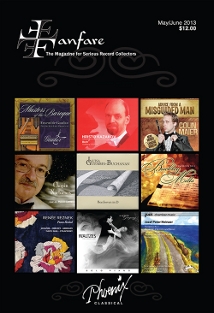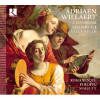Texte paru dans: / Appeared in:

Fanfare Magazine: 36:5 (05-06/2013)
Pour
s'abonner / Subscription information
Les abonnés à Fanfare Magazine ont accès aux archives du
magazine sur internet.
Subscribers to Fanfare Magazine have access to the archives of the magazine
on the net.
Ricercar
RIC331

5400439003316
(ID265)
Consultez toutes les évaluations recensées pour ce cd
~~~~ Reach all the evaluations located for this CD
This is a rerelease of an album that first appeared in 1996. It was reviewed at the time (Fanfare 20:2) by J. F. Weber, who wrote that it filled “a longstanding need. Let’s have a discful of his sacred music next.” We’ve had a few sacred discs since then, notably Willaert’s Vespro della beata Vergine with Capilla Flamenca (Ricercar 325), and his Missa Menta tota, plus motets, with Cinquecento (Hyperion 67749). Still, Willaert left roughly 150 motets, more than 70 madrigals, over 60 chansons, dozens of hymns, and eight surviving Masses. Very little of that output is available on record, and it’s all the more to be regretted when one takes into account the influence of his works and his teaching (both Cipriano de Rore and Andrea Gabrieli were among his students), and the international praise heaped upon his music by his knowledgeable, music-loving contemporaries.
So here we are again, with this rerelease of Willaert’s secular side. We have examples of his madrigals, considered among the first to interpret Petrarch in an ever-shifting, expressive weave. His chansons, first written during his Paris years when he studied with Jean Mouton, resumed in Italy after Ercole II d’Este’s marriage to Renée de France. Light-hearted Neapolitan villanelles occupy a comparatively small part of his oeuvre, though they illustrate how well he could manage the idiom.
Romanesque does not currently maintain a website, though several devoted to its leader, lutenist Philippe Malfeyt, mention the ensemble in the future tense. Perhaps it’s one of those groups that meet from time to time, or were never officially disbanded with the thought that they might someday get together once more. They’ve put out three discs in all. On this one, they include seven performers. Two provide viols, and a third, viol or cittern. Malfeyt, the lutenist, also supplies the rare instance of percussion, a fifth is a harpist, and a sixth performs on recorder. The seventh is soprano Kathelijne van Laethem, who takes the lead in much of this music, and who has a slender but attractive voice, well produced throughout its range, though the tone loses its shine and the breath support diminishes in the lower register. Her enunciation and phrasing are excellent, with added distinction from touches of musical characterization. Quante volte diss’io is taken seriously, and subtly; the far more famous Vecchie letrose, non valete niente is coarse, vindictive, and hilarious.
Romanesque treats all parts save one of Willaert’s madrigals as instrumentals: one of several standard performance practices at the time, though not as common today. Their performances are uniformly fine. The sound is suitably dry and clear, usually with good balance between all voices, singing and otherwise.
Weber asked for a disc of his
sacred music. Is it too ambitious to ask for double the number of secular
and sacred albums by the next time this album reappears? That frankly
wouldn’t require much effort at all, given the state of Willaert in the
music catalog. In the meantime, we have this, and it’s certainly worth the
purchase.
Fermer la fenêtre/Close window
Cliquez l'un ou l'autre
bouton pour découvrir bien d'autres critiques de CD
Click either button for many other reviews


